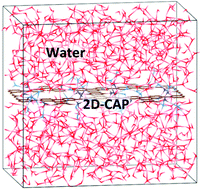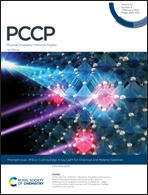Anomalous proton conduction behavior across a nanoporous two-dimensional conjugated aromatic polymer membrane†
Abstract
We investigate aqueous proton penetration behavior across a newly synthesized nanoporous two-dimensional conjugated aromatic polymer (2D-CAP) membrane using extensive ReaxFF reactive molecular dynamics simulations. We found that the proton penetration energy barrier across 2D-CAP is twice as high as that of graphtetrayne, even though 2D-CAP exhibits a larger pore size. Detailed analysis indicates that the anomalous high proton conduction energy barrier of 2D-CAP originates from its unique atomic nanopore structure. The hydrogen atoms at the periphery of the 2D-CAP nanopores can form a stable local hydrogen bond network with water molecules inside or surrounding the nanopores. The mobility of water molecules involved in this local hydrogen bond network will be significantly lowered, and the proton transportation process across the nanopores will thus be impeded. Our results show that the proton penetration behavior across nanoporous 2D materials is influenced not only by the pore size, but also by the decorated atoms or functional groups at the pore edges. Hydrogen atoms at the periphery of nanopores with certain geometry can form a stable local hydrogen bond network with neighboring water molecules, further hampering the proton conductivity.



 Please wait while we load your content...
Please wait while we load your content...